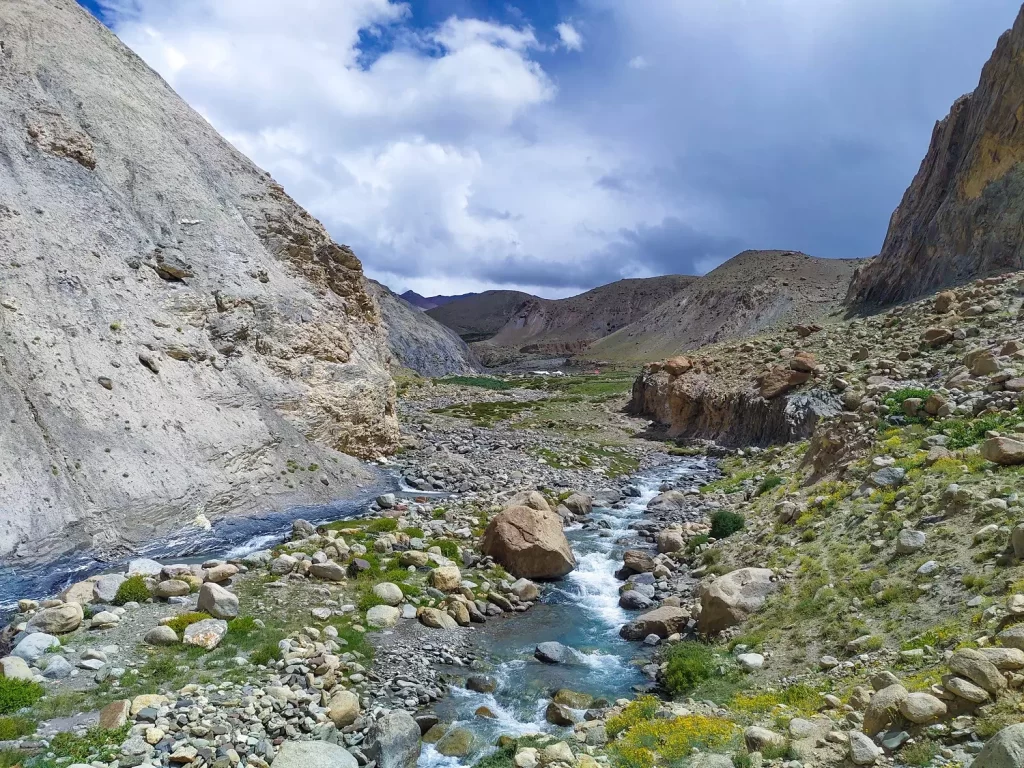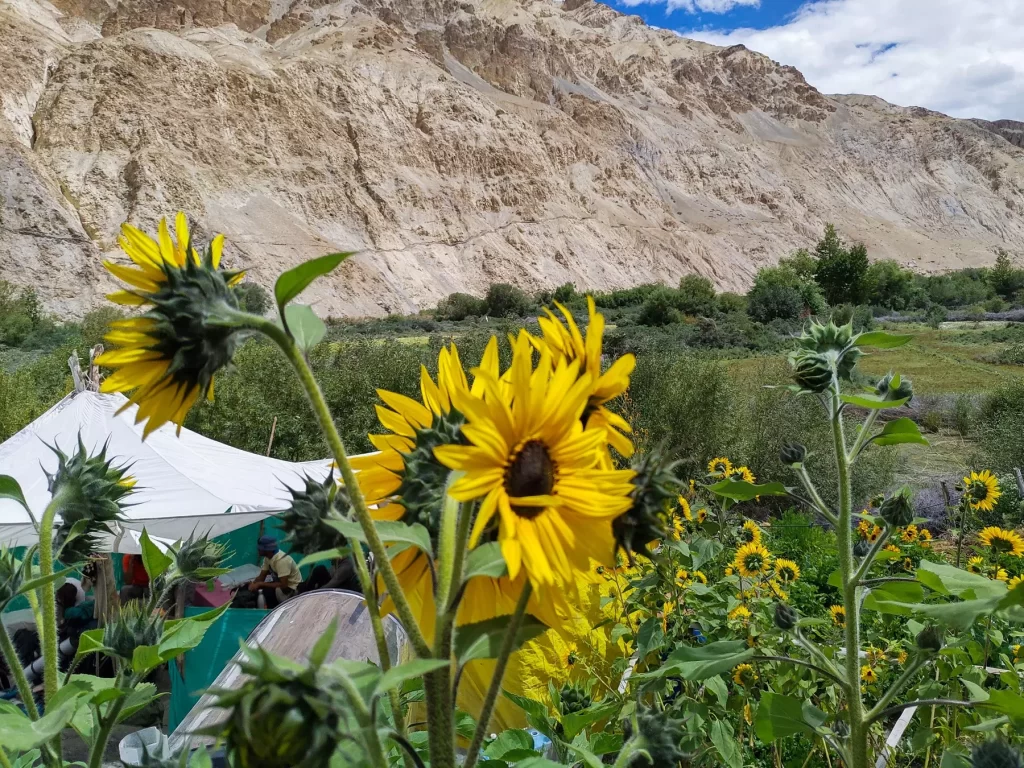

After arrival at Leh Airport, our cab will pick you up and transfer you to the hotel. You will be spending the night at The Bodhi Tree, one of the best rated accommodation in Leh.
Relax and rejuvenate at the Hotel. Tomorrow we set out to explore near Leh.
After a sumptuous breakfast at the hotel restaurant, we set out to explore in and around Leh.
We start with the Leh Monastery, which is an age old monument, also known as as the Lhachen Palkhar. King Sengge Namgyal built the Leh Palace during the 16th Century and it was completed by the 17th century.
The facades of the Leh palace resemble that of the Potala Palace in Lhasa.
In the evening we can visit the Leh Market and drive to Shanti Stupa for a vivid sunset.
Dine in a local restaurant with some local chamomile tea and a variety of local cuisine.
The day starts with a drive from Leh, early in the morning, along the Leh – Srinagar highway which runs parallel to Indus river. After 35 KM on this well paved beautiful road, we arrive at the confluence of Indus and Zanskar rivers, where we take a discourse towards south, parallel to river Zanskar, which now runs right along the road, and will continue to, until we arrive at Chilling. From chilling we are to cross the river, by taking the recently constructed bridge. The route ahead is an unpaved road, running now along the Markha river. Having already come across 3 different rivers, it sure is a delight.
We arrive at Skiu in 3 hours. After initial climb through hairpins, the route is very gradual, henceforth. Halfway we arrive at Village Kaya, and Skiu is another 3 KM up ahead. Skiu is a beautiful village tucked amidst tall mountains, with options for Homestay, as well as camping, but the recently constructed motorable road has provided the option to trek Further up to Sara, a hamlet, as if an Oasis in a desert. We rest and relish a warm meal, preferably a dish that goes by the name of this village, i.e. “Skiu”.
After breakfast, we start our trekking journey to Sara, which is around 11 KM ahead. We continue along this well marked trail running parallel to the river Markha. Halfway along the route we come across a Sole Tea Shop, which is women run. You can rest here, enjoy a cup of Tea or Coffee, but our favorite happened to be the fresh apricot juice which they happen to serve, although in limited quantities.
A stream cuts across the trail here, which can be used to refill your water bottles. The trail offers practically no shade except slightly ahead of the Tea Shop, where a short section of young trees render much need cool to the warm environment. To supplement yourself with water continuously is very important.
After around 3 KM we come across a bridge and cross over to the other side of the river, into a small forest patch, before the trail clears up again. The route is straight ahead along the river with only mild ascent all the way up the hamlet of Sara. The Hamlet will only appear once we are very close to the settlement, less than half a KM, where a hump in the landscape obstructs the view ahead. Once atop the feature, which is lined with a Stupa and prayer flags, we can see the beautiful settlement with 3-4 houses which all offer the option for Homestay, as we as camping. Green Fields, blossoming trees surrounding these houses are in stark contrast to the landscape all around.
The trail from Sara to Markha is again a gradual one, with no steep ascent and can be easily covered in 3-4 hours at a slow pace. After less than 2 KM from Sara we cross a bridge to our left which takes us to the true right of the river (i.e. river is now flowing on our right hand side).
Slightly further up we come across fields alongside a small village settlement, against backdrop of a steep mountain face. We continue along the trail, which slightly ascends to a higher open ground with a Stupa and Prayer stones (Mani stones), carved intricately. Take due note that you always cross these religious marking from the left (the stupa or prayer stones being on your right hand side). We quickly go downhill near the river and cross a small stream over a bridge of wooden logs.
Almost 2 KM prior to Markha village we again cross the river to our right with two bridges, one of which may be broken and will need some effort to traverse. With 1 more KM to go, we arrive at a Tea shop & Homestay with sunflowers blooming in their vicinity, offering a splendid sight with a stark contrast. A few more homestays and a campground are scattered ahead along the route, which hints at the proximity of Markha village. The last few hundered meters stretch to the village is a steep climb, which concludes in the arrival at the Monastery, followed by the village with its houses spread across the lush fields.
We can spend some time at the Monastery before we continue inwards. The village has a vivid historic past and unique culture, and the day can be spent exploring these.
The trek from Markha village to Hankar goes through a Monastery – the Tacha Gompa and a small settlement called Umlung. There are very few houses here with a couple of tea houses. You will see a large white canvas tent from far away as you approach Umlung.
The Tacha Gompa is inhabited by a sole Buddhist monk, who resides in the Gompa situated atop a steep cliff. A very steep staircase leads to the monastery situated a few hundred feet high above the valley below.
The last stretch to the village Hankar requires crossing a couple of more tea houses and then climbing up a steep section of trail that cuts through a cliff. As we reach the top we are welcomed by panoramic views of the Hankar village and its fields to the left, as well as a millennia old fort remains on a mountain top to the right.
After breakfast you may checkout from Hotel to either return from Leh or you may extend your travel for a guided/unguided tour of Ladakh including visiting places such as Khardunga La, Pangong Tso, Tso Moriri, Nubra Valley etc.
The Markha Valley trek is a well-known trekking route in the Ladakh region of northern India. It takes you through the stunning landscapes of the Hemis National Park, with views of snow-capped peaks, ancient monasteries, and remote villages.
The trek usually takes about 6 to 8 days to complete. This includes trekking, acclimatization, and rest days.
The best time for the Markha Valley trek is from mid-June to mid-September. During this period, the weather is relatively mild, and the trails are accessible.
Yes, a permit is required for trekking in the Hemis National Park, which encompasses the Markha Valley. This permit can be obtained in Leh.
It’s not mandatory to hire a guide, but it’s highly recommended, especially if you’re not experienced in high-altitude trekking. A guide can help with navigation, and acclimatization, and provide valuable local knowledge.
The trek is considered to be moderately challenging. Trekkers will face high altitudes, river crossings, and some steep ascents and descents. It’s important to be in good physical condition and have some prior trekking experience.
The highest point on the trek is the Kongmaru La Pass, which is situated at an altitude of approximately 5,100 meters (16,732 feet) above sea level.
Accommodation along the trekking route usually consists of homestays, guesthouses, and camping. The facilities are basic, and you’ll need to carry your own sleeping bag.
Some essentials include warm clothing, a good quality sleeping bag, trekking shoes, a raincoat, a water bottle, a first-aid kit, and personal toiletries. It’s important to pack light but ensure you have all the necessary gear.
The trek usually starts from a village called Spituk, which is about a 30-minute drive from Leh. You can reach Leh by air from major Indian cities like Delhi, or by road from Srinagar (in Jammu and Kashmir) or Manali (in Himachal Pradesh).
The main risks include high altitude sickness, sudden changes in weather, and rough terrain. It’s crucial to acclimatize properly, stay hydrated, and be prepared for varying weather conditions.
The Chadar trek can only be done during the months of January till February, therefore the roads to here are blocked due to heavy snowfall.
The way to reach here through the air is very convenient and Ladakh is accessible by air as well. One can easily schedule a flight to Leh Kushok Bakula Rimpochee Airport.
The cheapest way to reach from New Delhi to Leh is train to Jammu Tawi, then flight to Leh Kushok Bakula Rimpochee Airport and takes 13h 45m.
The fastest way to reach from New Delhi to Leh is flight to Leh Kushok Bakula Rimpochee Airport and takes 1h 15m.
Yes, it’s recommended to have your personal medicines and a simple first aid kit during any trek.
Pangong Lake: Journey 160 KM from Ladakh to reach the tranquil Pangong Lake. This world-famous tourist spot offers a range of activities, from camping to boating, against a backdrop of mesmerizing natural beauty.
Nubra Valley: Nestled between the Nubra and Shyok Rivers, Nubra Valley, often called the ‘Valley of Flowers,’ captivates visitors with its scenic vistas and cultural richness. From the ancient Diskit Monastery to charming Hindu temples, there’s much to explore.
Hemis Monastery: Hemis Monastery, situated near Hemis National Park, is one of India’s most renowned Buddhist monasteries. It’s famous for the annual Hemis Festival, a five-day celebration honoring Padmasambhava. Getting to this monastery is an adventure in itself, with breathtaking scenery and thrilling pathways along Pangong.
Shanti Stupa: Perched on a Chanspa hilltop, the white Shanti Stupa features a large Buddha sculpture. Part of the Peace Pagoda Mission, it’s renowned as one of the world’s top Buddhist sites. Inaugurated by the 14th Dalai Lama, it exudes serenity and a sacred atmosphere.
Gurudwara Pathar Sahib: This revered place is associated with Guru Nanak Dev Ji. Legend has it that a demon threw a rock at the Guru while he was meditating, and the boulder with imprints of his body parts is enshrined here.
Thiksey Monastery: Perched on a hill, this beautiful monastery belongs to the Gelug sect of Tibetan Buddhism. Dating back to the 1400s, it houses small temples, Buddhist relics, and nunneries. It’s not just a place of worship but also a spiritual haven for over 500 meditating monks.
Local Markets: Leh’s local markets are a treasure trove of souvenirs. Visit the Tibetan Market in the Main Bazaar to shop for spices, handicrafts, snacks, and more.
Khardungla Pass: For a scenic mountainous escape to Nubra and Shyok Valleys, journey along the 47.2 km Khardungla Pass, perched at an elevation of 17,852 feet. Marvel at panoramic views of the Himalayas and the Karakoram Range.